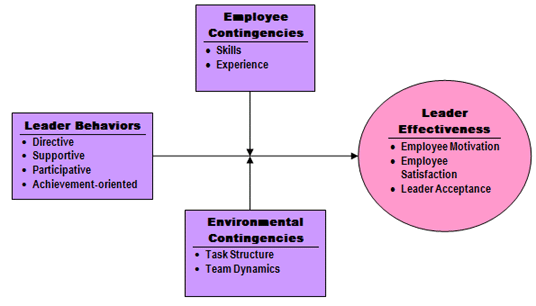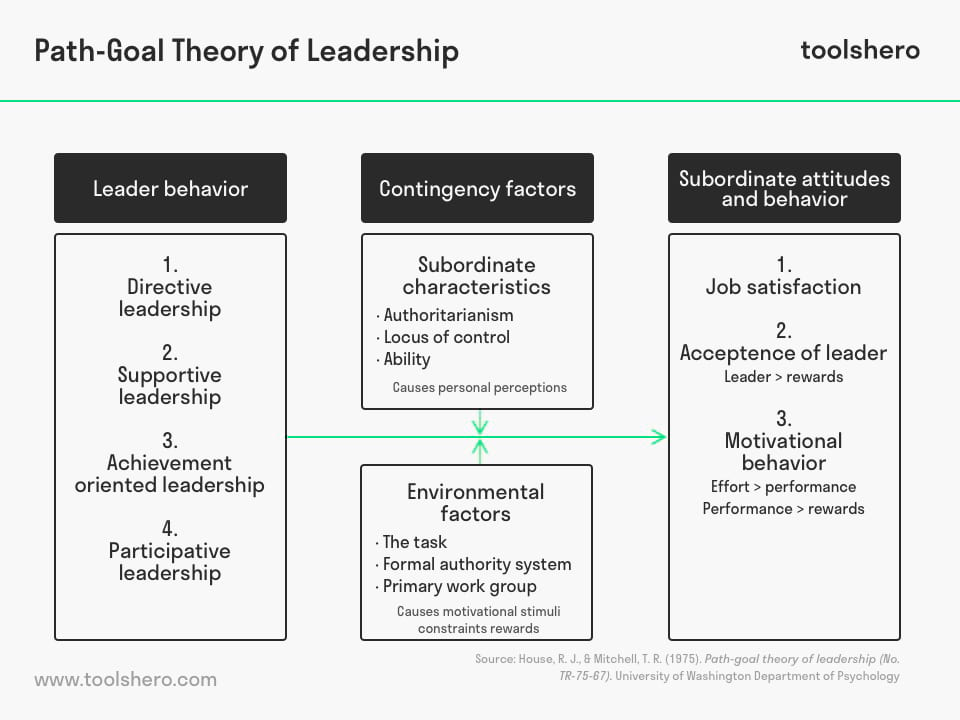Path Goal Leadership Theory Could Be Best Described as a
In path-goal theory the main components are ______ ______ and ________Leadership follower task. Path goal theory could best be described as a.

Path Goal Theory Of Leadership Leadership Theories Leadership Classes Leadership
Questions Answers Accounting.

. This applies to each of the four components of leadership. Path-Goal Leadership Theory. Pathgoal theory could be best described as aMotivational theory.
The different styles of leadership suggested by this theory provide ideas for how leaders can modify their behavior according to a situational experience or employees abilities and needs. The practical use of the theory is not valid. Northouse 2016 posits that this theory of leadership is concerned with enhancing follower performance and follower satisfaction by focusing on follower motivation p.
Path-goal theory suggests that leadership is a process by showing leaders that they have to get to know their followers and get to know the common goal heshe has with them over time in order to know how to best lead them in the correct direction. A disadvantage of path-goal theory is that its approach could faster subordinate dependency. Understanding path-goal theory can help you determine which leadership style will best motivate and improve your teams performance.
It is difficult to use the theory fully when trying to improve the leadership process. It allows the leader to have a wider range of options as leader. The manager should pick a leadership style that is specific to the personalities of the members of the group.
A Path-Goal Leadership theory is a form of theory in which leaders are adaptable and fast to change and they help. It extracts the essence of the expectancy theory of motivation and the Ohio State leadership research on initiating structure and consideration. The type of rewards used depends on the situation particularly what the.
The leader the follower and the situation. The Path-Goal Theory is a great approach to evaluating leadership. The main concept of the Path-Goal Theory is how leaders use rewards to motivate their followers PSU World Campus 2013.
Which leadership theory is studied in a variety of disciplines including nursing education. The Path-Goal Theory is a leadership theory that was developed in the 70s of the last century by American management guru and expert in the field of leadership in various cultures Robert J. In the most simplistic terms path-goal theory is about how leaders motivate their followers to accomplish goals Penn State University World Campus PSU WC 2016 L.
By matching these leadership styles with correlating employee tasks and needs the theory predicts successful goal attainment and employee satisfaction. Path-goal leadership is an approach to leadership for which many management-training programs have been developed. It fails to determine the role of motivation.
Path - goal theory is similar to the situational approach in that. The Path-Goal model is a theory based on explaining a leaders style or behavior that is best suited to the employee and workplace to achieve a common goal. The theory suggests that one leadership style is not better in all.
Path - goal requires leaders to adapt. Path-goal theory is similar to the situational approach in thatPath-goal requires leaders to adapt to followers needs. Path-Goal Leadership identifies four leadership behaviors Northouse 2016 p.
The Path-Goal Theory of Leadership was developed to describe the way that leaders encourage and support their followers in achieving the goals they have been set by making the path that they should take clear and easy. Answer of Path-Goal Leadership theory could be best described as a Group of answer choices Great person theory Transformational theory Motivational theory Trait. The Path Goal Theory created by Robert House is a management theory that states that the managers leadership style is a major factor in worker motivation productivity and job satisfaction.
The path-goal theory can best be referred to as a set of processes in which leaders choose specific behaviors that are good for the employees needs and their working environment so. Path-Goal Leadership theory could be best described as a Group of answer choices Great person theory. Once a leader adjusts hisher style to match a followers needs he.
The Path-Goal model is a theory based on specifying a leaders style or behavior that best fits the employee and work environment in order to achieve a goal House Mitchell 1974. Participative leadership is effective with subordinates who have a an internal locus of control. Path-goal leadership is an approach to leadership for which many.
Path-Goal Theory of Leadership Explained Path-Goal Theory developed by Martin Evans and Robert House related to the contingency approach is derived from the expectancy theory of motivation. The Path Goal Leadership Theory is developed by Robert House and basically states that leaders will adjust and adapt to behaviors that will play to the strengths of their subordinates and compensates their weaknesses. In this leadership theory they assume that a leader complements her or his employees and.
House and American organisational expert Terence R. Pathgoal theory is based on motivation principles drawn from expectancy theory. According to path-goal theory which behavior best describes your supervisor.
The goal is to increase your employees motivation empowerment and satisfaction so they become productive members of the organization. House introduced new behaviors in his reformulated path-goal theory in 1996. Clarify the path so subordinates know which way to.
It incorporates the three main focuses of leadership.


Comments
Post a Comment